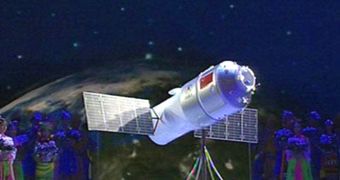Some time ago, the China National Space Administration (CNSA) announced plans to create its own space station in low-Earth orbit. The construct is planned to be assembled from at least three different spacecrafts, and now officials from the agency announce that they are putting the project into overdrive. According to the new plans, the three space vehicles will be launched between the first half of 2011 and 2016. Once joined in orbit, they will represent the foundation of the new space station.
Yesterday, April 14, the director of the CNSA Chinese Manned Space Engineering Office (CMSEO) told attendants at the 26th National Space Symposium, in Colorado Springs, that the first spacecraft would be launched no later than the first half of 2011. Tiangong 1 will represent the Asian nation's first step in ensuring its continuous presence in orbit, said CMSEO Director General Wang Wenbao. China is the third nation in the world to attain human launch capabilities, after the United States and Russia. The other two nations also constructed their own space station before the ISS project was set into place.
Chinese taikonauts (astronauts) managed to conduct their first successful spacewalk in 2008, during the country's third manned space mission, Shenzhou 7. “Space is the common resource of all humankind. The basic curiosity, desire to explore the unknown, are all the same universal human nature,” the official told Space in an interview. For next year, the CNSA plans to also launch the Shenzhou 8 spacecraft, in the second half of the year. The module will dock to Tiangong 1. If successful, this will be the first in-orbit rendezvous and docking maneuver for China. In 2012, the Shenzhou 9 and 10 spacecrafts will also dock to the emerging station.
The second large module will be the Tiangong 2 module, which is currently scheduled for launch in 2013. The third addition, Tiangong 3, will be launched sometime between 2014 and 2016, but it will not represent the last addition to the orbital facility. According to the CNSA, station construction will last until 2022. After that time, the lab will be operated for about three years, during which time taikonauts will perform numerous scientific experiments, in fields such as life sciences, materials sciences, and agriculture. The station will also be used for military purposes.

 14 DAY TRIAL //
14 DAY TRIAL //